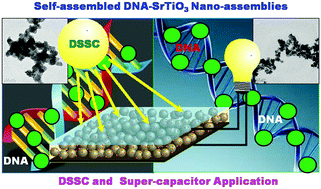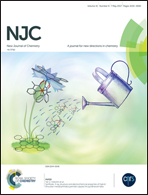Low-temperature synthesis of SrTiO3 nanoassemblies on DNA scaffolds and their applications in dye-sensitized solar cells and supercapacitors†
Abstract
A new route toward the fast synthesis of aggregated, chain-like, one-dimensional SrTiO3 nanoassemblies on DNA scaffolds utilizing a simple room-temperature wet-chemical route is reported. SrTiO3 nanoassemblies were synthesized from titanium isopropoxide and strontium oxide in presence of aqueous DNA solution. The individual SrTiO3 NPs with diameters ∼25 ± 10 nm aggregated and self-condensed to generate a chain-like morphology. The specific sizes of the individual NPs and diameters of the assemblies could be tuned by controlling the starting reagent concentrations and other reaction parameters. The mechanism of formation and growth is discussed in detail. The synthesized SrTiO3 nanoassemblies on DNA scaffolds have been utilized as excellent anode materials in two energy-related applications: dye-sensitized solar cells (DSSCs) and electrochemical supercapacitors. DSSC studies showed that both morphologies could be used as potential anode materials in photovoltaic applications, while the supercapacitor studies showed that small-sized SrTiO3 nanoassemblies gave a higher specific capacitance than the large-sized morphology. The present synthetic method is simple, cost-effective, robust, and less time-consuming, takes place at room temperature, and could be extended to other energy-related applications, such as lithium-ion batteries or thermoelectrics in future.



 Please wait while we load your content...
Please wait while we load your content...